Key Points:
- Venom immunity means an animal has the ability to completely nullify the effects of a snake’s venom. Resistance, on the other hand, gives potential prey an advantage if they are bitten.
- In 1976 in a research lab at Texas A&M, it was accidentally discovered that the woodrat is immune to the bite of a rattlesnake when it was fed to one and didn’t suffer any effects after being bitten.
- While non-venomous themselves, kingsnakes prey on rattlesnakes and other pit vipers and are almost completely resistant to their venom.
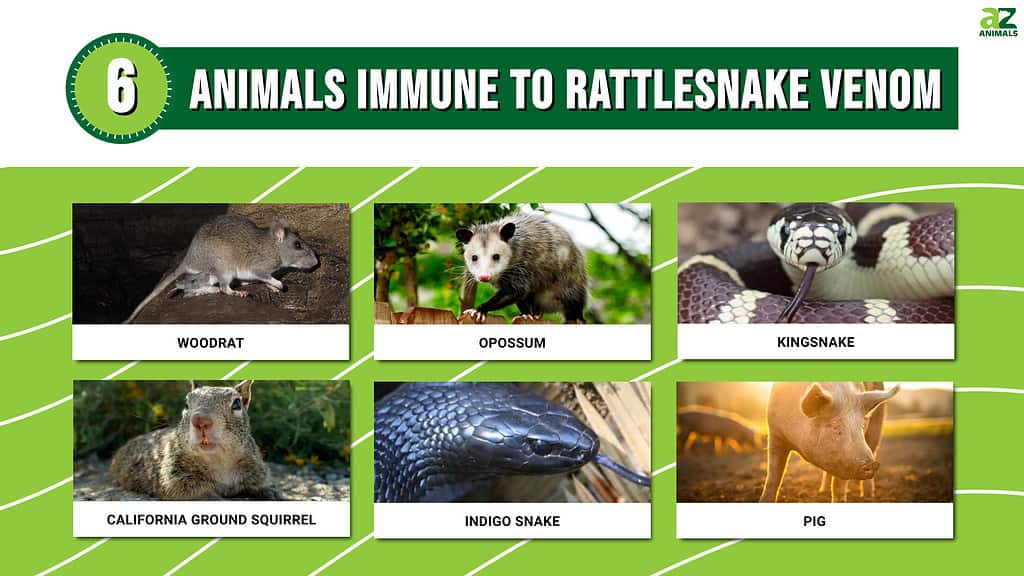
Rattlesnakes are some of the most dangerous animals in the United States, with the eastern diamondback rattlesnake often considered the deadliest snake in the country. These snakes are found in many environments and are top predators wherever they live. That characteristic rattle is usually all it takes to warn away a potential threat! Still, there are some incredible animals that have evolved specific defenses to rattlesnakes in order to survive. Today, we are going to be learning all about 5 animals immune to rattlesnake venom, plus a bit about some other animals with similar resistances.
Let’s get started!
Can animals be immune to venom?
Before we begin, it’s important to understand the difference between immunity and resistance. Many of the following animals have venom resistance, meaning they have developed some way to combat snake venom through their evolutionary history, but it isn’t always perfect. Venom resistance gives potential prey an advantage if they are tagged by a venomous snake, but they probably don’t want to make a habit of it! Immunity, on the other hand, is the complete ability to nullify the effects of a snake’s venom.
Each of the animals below will have some level of resistance to snake venom but may not be totally immune. Additionally, we are going to cover resistance to rattlesnake venom specifically, although there is often overlap when it comes to the venom of other snakes. As a result, all of these animals will live in North America since that is where rattlesnakes live!
These adaptations are truly remarkable, and a few of the contenders on the list are likely to surprise you!
A list of the animals immune to rattlesnake venom
1. Woodrats
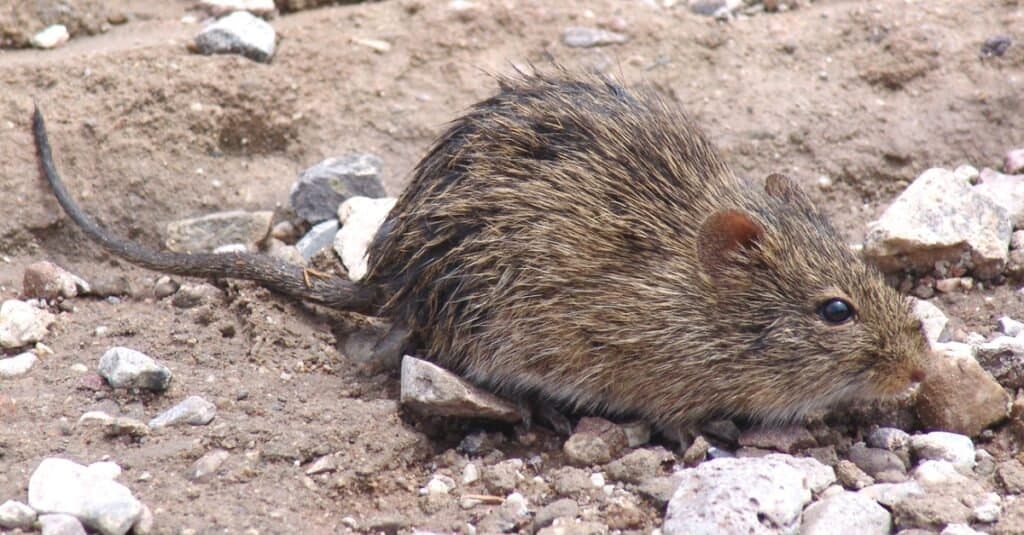
Woodrats were accidentally discovered to have immunity to rattlesnake venom.
©iStock.com/rtrible
One of the most surprising animals on the list is the woodrat. Woodrats are commonly known as packrats due to their habit of collecting things in their dens and burrows. The discovery that woodrats had a natural immunity to rattlesnake venom was completely an accident and occurred during a science experiment in a classroom!
In 1976, a student at Texas A&M University was asked to feed one of the snakes that belonged to the research center at the school. Grabbing a rodent, the student gave the western diamondback in their care a woodrat, thinking his job was done. Watching, the rattler struck, and the fight was over… but it wasn’t. The mouse was incredibly unaffected. When the student saw what had happened, further research was conducted, and the shocking discovery was revealed!
2. Kingsnakes

Kingsnakes regularly eat venomous snakes, giving them their name as the king of snakes.
©iStock.com/JasonOndreicka
You don’t get to slither around with the name “kingsnake” if you aren’t the true king of snakes. Thankfully, kingsnakes come by their title honestly. They actually get their name from their habit of preying on other snakes as their primary source of food.
Kingsnakes regularly prey on the most venomous species of snakes in the US, including copperheads, rattlesnakes, and cottonmouths. There are various species of kingsnake across the United States, and all of them love to snack on rattlesnakes like they are gummy worms! Incredibly, kingsnakes aren’t even venomous themselves, preferring to constrict their food. Kingsnakes have the strongest relative constriction of any snake in the world.
The resistance of kingsnakes comes from a special enzyme that inhibits the binding of pit viper venom, rendering it mostly ineffective. Although they aren’t totally “immune,” they are strongly resistant.
3. Indigo snakes
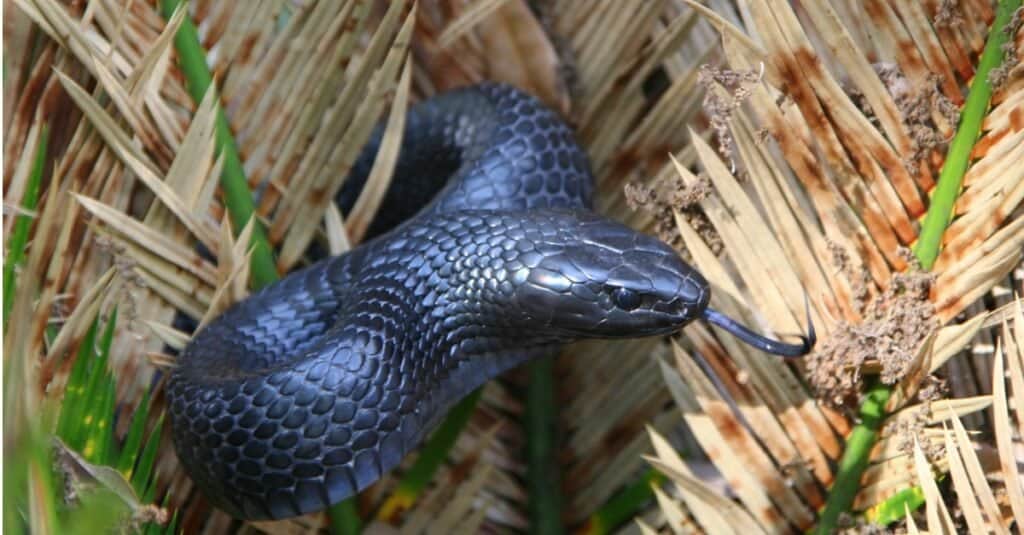
The eastern indigo snake is a large nonvenomous snake that eats other snakes as a primary prey source.
©iStock.com/sstaton
The eastern indigo snake is another snake that has developed immunity to all North American rattlesnakes. Since the eastern indigo snake occupies the same locations as many rattlesnake species, and they are immune to their toxic venom, the eastern indigo snake is a dangerous predator to rattlesnakes, feeding on them at will.
Indigo snakes are themselves nonvenomous and similar in size to the eastern diamondback rattlesnake. They are truly beautiful snakes, although they are currently threatened across much of their range in the southeastern United States. They can currently be found in Georgia, Alabama, Mississippi, and South Florida. They like to dwell in longleaf pine forests, which have been reduced to less than 5% of their original historic size. At one point in the mid-1950s, indigo snakes became completely extinct in Alabama but were reintroduced by animal researchers in the 80s. They’ve also been caught in large numbers for the pet trade, which has reduced their numbers in the wild.
4. California ground squirrel
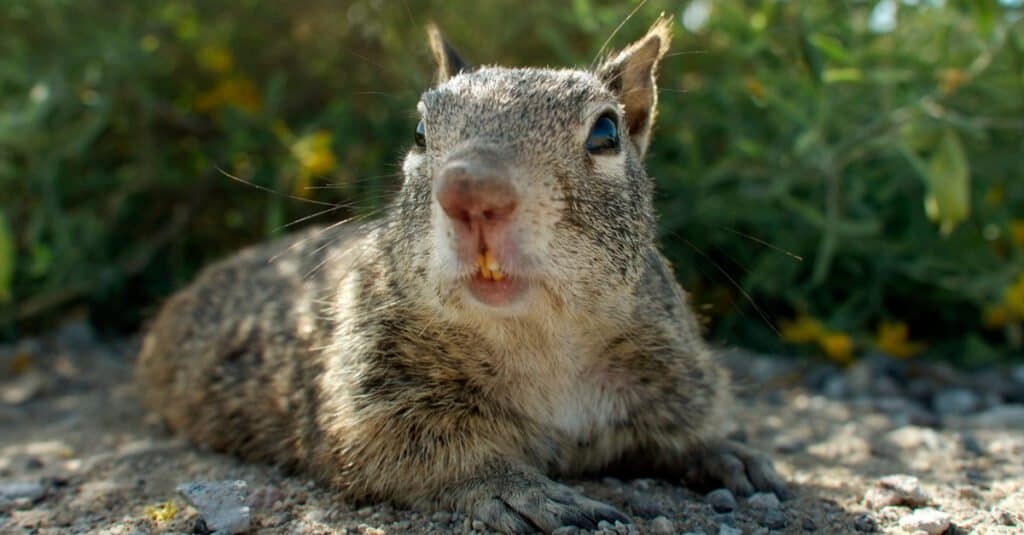
Some populations of California ground squirrels have developed a resistance to rattlesnake venom.
©Salty View/Shutterstock.com
Another surprising member on our list, the California ground squirrel seems to be the most unlikely animal to be resistant to rattlesnake venom! Ground squirrels are some of the rattlesnake’s most common foods, making the resistance even more surprising in some ways.
There are many species of ground squirrels, and not all of them are immune. The California ground squirrel has a unique resistance to rattlesnake venom that is directly associated with the presence of rattlesnakes in their environment.
One population was obtained from a habitat with a high rattlesnake density; the other population came from a rattlesnake-free habitat. Dramatic differences in the response to venom between these populations were manifested, based on a variety of criteria, such as mortality, necrosis, and healing time.
Resistance of California ground squirrels
Another adaptation these squirrels use to defend against rattlesnakes is truly remarkable. When they encounter the shed skin of a snake, they will chew it up and spread it across their bodies to mimic the smell. Since snakes hunt by smell, these squirrels effectively camouflage themselves with the skin of their top predator.
5. Opossums

The
possum
has developed an immunity to rattlesnake venom through a special peptide.
©Lisa Hagan/Shutterstock.com
Opossums (commonly referred to as possums) live across most of the United States and are some of the oldest mammals around. They have developed a natural immunity to resist pit viper venom, of which the rattlesnake is included. In fact, they are so good at producing a special peptide that completely neutralizes the venom that studies are currently being done on them to discover potential uses.
An eleven amino acid ribosomal peptide was shown to completely neutralize Western Diamondback Rattlesnake (Crotalus atrox) venom in mice when a lethal dose of the venom was pre-incubated with the peptide prior to intravenous injection.
Opossum peptide that can neutralize rattlesnake venom
6. Pigs
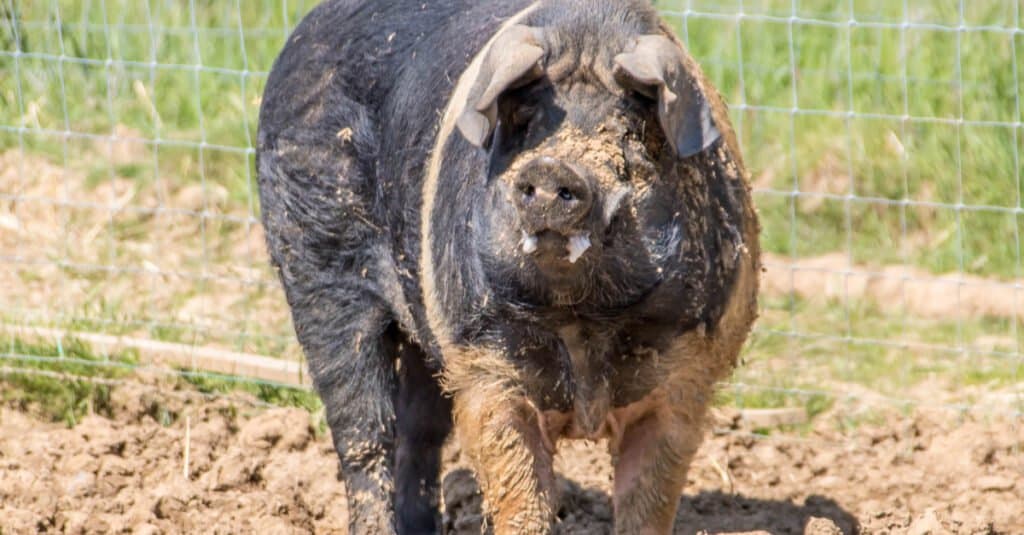
Domestic pigs are hardy animals with resistance to many snake venoms, including the rattlesnake.
©Penny Hicks/Shutterstock.com
Although they are generally regarded as silly, sloppy creatures, pigs are incredibly hardy animals descended from the wild boar. Wild boar spend their lives foraging for food in the places where snakes love to hang out, so it makes sense that they would have developed a natural immunity to some of their venom.
There is a common belief that pig fat helps to reduce the damage done by snakes, but research has shown that their fat doesn’t do much since the venom can easily travel through it. Still, there is another mechanism that gives them their resistance. Their resistance is to the a-neurotoxin in snake venom, specifically. Domestic pigs have a genetic mutation in their cell receptors that prevents binding of the a-neurotoxin, rendering the venom useless.
The resistance doesn’t occur in most pigs until they are adults, so small pigs are still vulnerable. This is likely the reason that pigs are known to actively attack snakes that are near their enclosure. It’s a behavioral defense response to their piglets not being immune quite yet.
Animals that could be immune to rattlesnake venom
Since rattlesnakes only live in the Americas, the primary creatures that are immune to them live there as well. Still, there are some animals that could be immune if they happened to run into one of these scary snakes.
Hedgehog

Hedgehogs have resistance to snake venom but aren’t totally immune.
©Elijus3000/Shutterstock.com
These cute little animals live in Africa and are known for their little spines and habit of curling up as a defense. Their spines act as a physical defense, but they also have a hidden defense found within their bodies.
Molecular mechanisms of venom resistance (as indicated by biochemical research on opossums, mongooses, and hedgehogs) include toxin-neutralizing serum factors and adaptive changes in venom-targeted molecules.
Snake-venom resistance as a mammalian trophic adaptation
These adaptations are important for these little creatures since they make a habit of eating other snakes, especially venomous ones! Although they aren’t totally immune, the added resistance can help if they accidentally get tagged by a fang.
Honey badger

Up to 25 percent of the honey badger’s omnivorous diet consists of venomous snakes.
©Erwin Niemand/Shutterstock.com
One of the more famous examples of a venom-resistant animal is the honey badger. These creatures are famed for their incredible toughness and the ability to steal honey from hives without any ill effects. There are two things that help keep them safe from dangerous snakes: their skin and their genes.
Honey badgers have incredibly tough skin that is known to deflect human machete chops. If a snake can’t get its fangs into you, it can’t get the venom in either! Additionally, honey badgers have developed a natural immunity to Elapidae venom.
Honey badgers (Mellivora capensis) prey upon and survive bites from venomous snakes (Family: Elapidae), but the molecular basis of their venom resistance is unknown. The muscular nicotinic cholinergic receptor (nAChR), targeted by snake α-neurotoxins, has evolved in some venom-resistant mammals to no longer bind these toxins. Through phylogenetic analysis of mammalian nAChR sequences, we show that honey badgers, hedgehogs, and pigs have independently acquired functionally equivalent amino acid replacements in the toxin-binding site of this receptor.
Why the honey badger don’t care
Mongoose
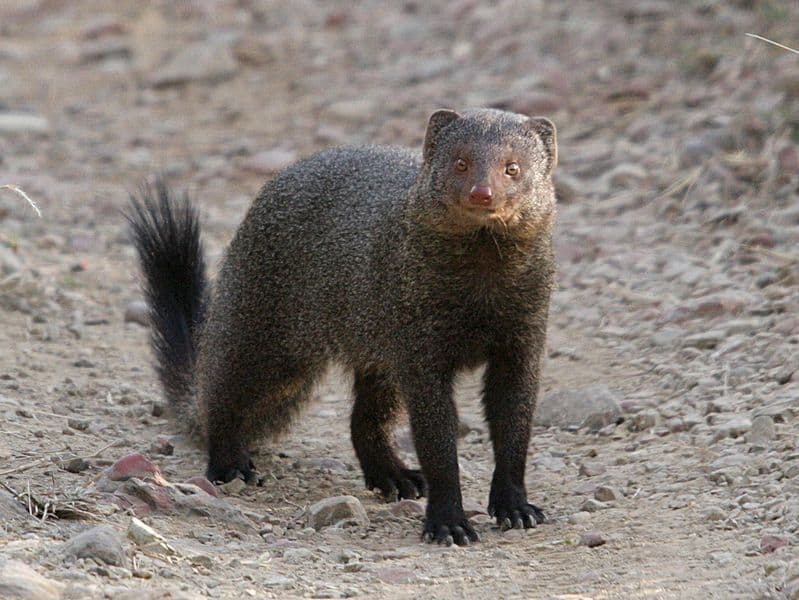
The speed and venom resistance that mongooses have allows them to feed on the world’s deadliest snakes.
The mongoose is probably the most famous of all the venom-resistant animals on our list. They aren’t totally immune, but they are well-known as hunters of even the deadliest of snakes. Their speed and venom resistance combine to make them one of the best snake hunters around.
Molecular biologist Sara Fuchs and her colleagues found that the acetylcholine receptor in mongooses–like that in the snakes themselves–is slightly mutated so that the venom simply bounces off the muscle cells, causing them no harm.
LA Times
Honorable Mentions: More Animals Immune to Venomous Bites
There are few animals that have some degree of resistance to rattlesnake bites. A couple more animals that do have some resistance to rattlesnake venom include:
- Skunk (Mephitis mephitis): This little stinky critter, like the opossum, also shows resistance to rattlesnake venom.
- Coachwhip Snake (Masticophis flagellum): Besides kingsnakes, coachwhip snakes may also have some resistance to rattlesnake venom, though the jury is out on that fact. However, they do actively prey on them.
Summary of 6 Animals Immune to Rattlesnake Venom
Let’s recap the animals known to be immune to rattlesnake venom:
| Rank | Immune Animal | Scientific Name |
|---|---|---|
| 1 | Woodrats | Neotoma cinerea |
| 2 | Opossums | Didelphis virginiana |
| 3 | Kingsnakes | Lampropeltis californiae |
| 4 | California Ground Squirrel | Otospermophilus beecheyi |
| 5 | Indigo Snakes | Drymarchon melanurus |
| 6 | Pigs | Sus domesticus |
Bonus: Which U.S. State Has the Most Snake Bites?

The venomous copperhead snake is among those responsible for snake bites in North Carolina.
©Mark_Kostich/Shutterstock.com
Humans are not animals, but we are mammals that are susceptible to the toxicity of venomous snake bites. If you live in a state like Alaska, Hawaii, or Maine, you have no reason to worry, as those are the only 3 U.S. states that do not have any venomous snakes. But there are other states where many venomous snake bites occur on a yearly basis.
So which state ranks the highest in snake bites? That would be North Carolina. The snake bite rate in this southeastern state is 157.8 bites per million population annually. As the population as of 2021 was a little over 10 million (10.55 to be exact), and we were to just figure it off of 10 million, that would average out to roughly 1,580 reported snake bites per year.
The top 6 states for reported snake bites are:
| Rank | State | Bites per Million |
|---|---|---|
| 1 | North Carolina | 157.8 |
| 2 | West Virginia | 105.3 |
| 3 | Arkansas | 92.9 |
| 4 | Oklahoma | 61 |
| 5 | Virginia | 48.7 |
| 6 | Texas | 44.2 |
There are 6 different kinds of venomous snakes inhabiting North Carolina: copperhead, cottonmouth, eastern coral snake, eastern diamondback rattlesnake, pigmy rattlesnake, and timber rattlesnake. In the year 2019, there were 92 people bitten by venomous snakes in that state.
The photo featured at the top of this post is ©
Thank you for reading! Have some feedback for us? Contact the AZ Animals editorial team.






